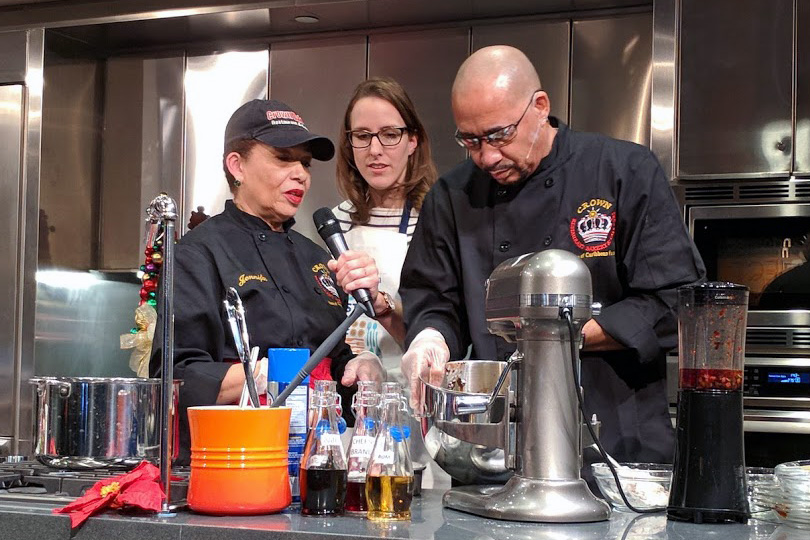Jennifer Selman is the owner and chef of Crown Bakery, specializing in delicious Trinidadian baked goods, take-away hot foods, and buffet brunch in the 16th Street Heights neighborhood of Washington, D.C. She came to the United States from Trinidad with her husband, and moved to the area about eighteen years ago.
Though she first trained as a fashion designer, Selman grew up cooking with her family and enjoying the foods of their homeland. Her brother Wayne trained as a baker. They saw a need for a good Caribbean bakery and café in D.C., so they opened Crown. Just as she approached the fashion industry, Selman brought her motto of “Passion, Preparation, Presentation” to the restaurant.
On the ground floor, displays of fruit-studded pastries and breads and hot dishes like oxtail stew and greens fill the air with delicious smells. On the second floor, a buffet dining area sets the stage for families to enjoy all-you-can-eat traditional food. Customers drop by daily for a pastry, news, and conversation, and Sunday brunches are filled with families and friends who share stories.

We collaborated with Selman recently to present a cooking demonstration on December 2 at the Smithsonian Holiday Festival, a weekend-long event at the National Museum of American History. Part of the orgoing Cooking Up History series, this program celebrated the 50th anniversary of the Smithsonian Folklife Festival and our long association with foodways of immigrant communities in D.C. We planned this particular session to give a “taste” of a Caribbean American celebration.
While Selman enjoys making many traditional Trinidadian and Caribbean dishes, we had to find a dish that would represent holiday traditions. To help understand the traditions more deeply, we consulted with Camila Bryce-LaPorte, a longtime Folklife Festival associate and immigrant from Panama, who introduced us to Selman and accompanied us on our visits to the bakery. During a lively interview with Selman and Bryce-LaPorte, they discussed making fruitcake, or black cake, a Caribbean holiday staple.
“It’s so much fun and it brings back memories,” Selman said, her facing lighting up recalling helping and grinding the fruit by hand as a child. “The taste, the feeling of Christmas, just the ambiance of the Christmas spirit comes just by the smell of the cake.”
Bryce-LaPorte is the last person in her family to continue the fruitcake tradition. As her grandparents moved throughout the Caribbean, they continued to make fruitcake, despite the fact that it’s not a cheap cake to make.
“It’s very expensive,” she said. However, “It’s a symbol of home. It’s very important.”


Prior to the demonstration at the museum, Selman and her brother Wayne carefully laid out the pre-measured ingredients, including four kinds of dried fruit, and an array of spices and flavorings. Museum presenter Ashley Rose Young masterfully kept the cooking on track while allowing Selman and Bryce-LaPorte to share how their recipes have changed over time, their childhood memories of helping make fruitcakes at home, and other holiday traditions.
Even from the audience, we could smell the delicious scents. Just the smell of lime zest, Selman said, brings her right back to her childhood Christmases. “The memories are locked in,” she said.
Wayne contributed his memories while helping prepare the fruits, mixing the batter, and getting the cake into the oven. Then he turned to spicing and steeping the sorrel, a tangy jewel-toned drink made from hibiscus flowers and spices, common around the holiday season.
Toward the end of the program, the participants described the musical holiday tradition of parang, walking from house to house while singing and playing instruments at night. As a surprise for the audience, local artist and educator Hollis “Flash” Lashley sang and played his cuatro (small guitar) in the parang style to round out the demonstration and the Caribbean holiday traditions theme.

Find the recipes for Trinidad black cake and sorrel drink.
Hannah Elbaum is studying American studies, education, and museum studies at Smith College in Massachusetts. She spent the fall 2017 semester interning at the Center for Folklife and Cultural Heritage working on food-related projects, a fascinating and delicious topic.


